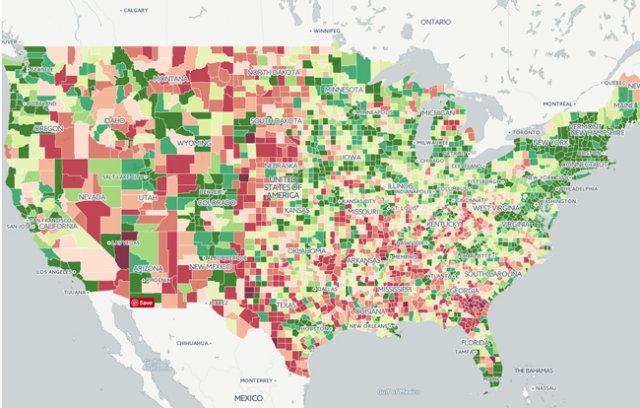America's Foremost Arts Cities
Pittsfield Makes the List
By: SMU DataArts - Dec 15, 2022
SMU DataArts, the National Center for Arts Research, today released the Arts Vibrancy Index, which examines the level of supply, demand, and government support of the arts in more than 900 communities across the country. Accompanied by an interactive Arts Vibrancy Map that reveals the arts-vibrancy score of every county in the U.S., the Index lists, in alphabetical order, the 20 most arts-vibrant large cities, the 10 most arts-vibrant medium cities, and the 10 most arts-vibrant small cities. In this year’s Index, the first since 2020, four communities debut on the lists and an additional five return after an absence of at least three years.
Key movements and new communities featured on the lists include:
- Salt Lake City, UT, is new to the Index and is featured on the list of the 20 most arts-vibrant large cities.
- Ann Arbor, MI, and Kalamazoo-Portage, MI, also new to the Index, are featured on the list of the 10 most arts-vibrant medium communities.
- Brevard, NC, makes a debut on the list of the 10 most arts-vibrant small cities.
- Five cities reclaimed spots on the lists after an absence of at least three years: Denver-Aurora-Lakewood, CO (large); Des Moines-West Des Moines, IA, and Missoula, MT (medium); and Key West, FL, and Easton, MD (small).
The Arts Vibrancy Index report is an indispensable resource for anyone seeking to better understand how the arts and culture sector contributes to a community’s economy and public life. Now in its seventh iteration, the report has helped organizations evaluate where to relocate or focus their operations; provided clarity for funders on how and where to invest; and made it easier than ever for communities to learn how to cultivate arts vibrancy in their area. The report’s data-driven evidence has helped mayors, city council members, and state legislators understand how the communities they serve can benefit from greater recognition and increased funding for the arts. New to this year’s report, an analysis of the impact of the coronavirus pandemic on the arts and culture sector equips leaders with a critical tool to benchmark their communities’ responses to the crisis.
“The return on an investment in the arts is a community that pulsates with life, vigor, and activity,” said Dr. Zannie Voss, Director of SMU DataArts. “In our first Arts Vibrancy Index report to evaluate data collected after the emergence of the coronavirus pandemic, we heard from communities that emergency relief from local and state governments empowered arts organizations to serve their constituents in innovative ways, from donating space or resources to amplifying conversations on equity. Simply stated, arts vibrancy did not go dormant throughout the pandemic. In this report, we reflect on arts vibrancy from a place of gratitude and express our solidarity with communities as they continue to meet the moment with awe-inspiring resilience.”
The Lists
The Arts Vibrancy Index features communities from every region of the country, a finding which arises from an objective analysis of the data, and not from identifying communities selectively to achieve geographic representation. Full details on the SMU DataArts methodology can be found on the Arts Vibrancy Index website. Despite the disruptions of the pandemic, many communities maintained their arts vibrancy though increased virtual offerings, more robust outdoor programming, and other adjustments to traditional operations. To help communities learn from each other’s successes and adapt to enduring shifts induced by the pandemic, SMU DataArts will publish community profiles that incorporate the perspectives of local leaders in the first half of 2023.
Large Cities
Among cities with populations greater than 1 million people, one community joins the list for the first time: Salt Lake City, UT. Additionally, Denver-Aurora-Lakewood, CO, returns to the list for the first time since 2019.
The 20 most arts-vibrant large communities, listed in alphabetical order, are as follows:
- Austin-Round Rock-Georgetown, TX
- Boston, MA
- Cambridge-Newton-Framingham, MA
- Chicago-Naperville-Evanston, IL
- Cincinnati, OH-KY-IN
- Cleveland-Elyria, OH
- Denver-Aurora-Lakewood, CO
- Frederick-Gaithersburg-Rockville, MD
- Los Angeles-Long Beach-Glendale, CA
- Minneapolis-St. Paul-Bloomington, MN-WI
- Nashville-Davidson-Murfreesboro-Franklin, TN
- New Orleans-Metairie, LA
- New York-Jersey City-White Plains, NY-NJ
- Newark, NJ-PA
- Philadelphia, PA
- Portland-Vancouver-Hillsboro, OR-WA
- Salt Lake City, UT
- San Francisco-San Mateo-Redwood City, CA
- Seattle-Bellevue-Kent, WA
- Washington-Arlington-Alexandria, DC-VA-MD-WV
Medium Cities
Two communities with populations of 100,000 to 1 million are new to the medium-cities list: Ann Arbor, MI, and Kalamazoo-Portage, MI. In addition, Des Moines-West Des Moines, IA, returns to the list for the first time since 2017, and Missoula, MT, returns to the list for the first time since 2019.
The 10 most arts-vibrant medium communities, listed in alphabetical order, are as follows:
- Ann Arbor, MI
- Boulder, CO
- Bozeman, MT
- Des Moines-West Des Moines, IA
- Ithaca, NY
- Kalamazoo-Portage, MI
- Missoula, MT
- Pittsfield, MA
- San Rafael, CA
- Santa Fe, NM
Small Cities
Among small communities, defined as areas with an urban core of 10,000 to 50,000 people, one city is new to the list: Brevard, NC. Returning to the list for the first time since 2016 is Easton, MD, and returning for the first time since 2018 is Key West, FL.
The 10 most arts-vibrant small communities, listed in alphabetical order, are as follows:
- Bennington, VT
- Brevard, NC
- Easton, MD
- Glenwood Springs, CO
- Hailey, ID
- Hudson, NY
- Jackson, WY-ID
- Key West, FL
- Steamboat Springs, CO
- Vineyard Haven, MA

